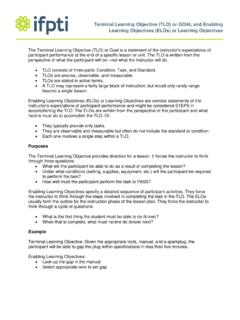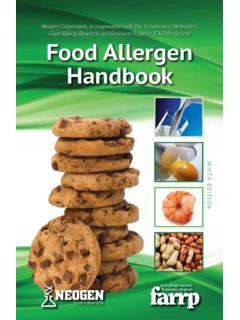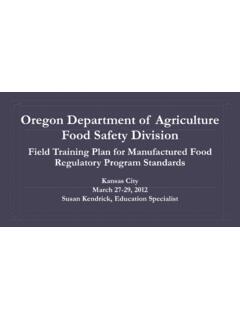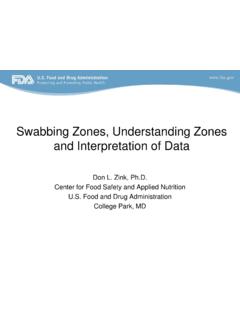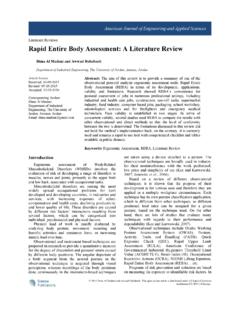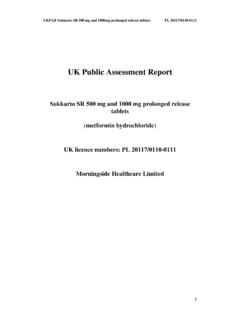Transcription of Safe Practices for Sausage Production
1 safe Practices for Sausage Production Sponsored by: The Department of Agriculture (USDA), Food Safety and Inspection Service (FSIS), and The Association of Food and Drug Officials (AFDO) In cooperation with the Food and Drug Administration (FDA) Version 1 April 2014 Index Page Introduction .. 1 Examples of Sausage Products .. 3 Producing Sausages .. 4 Cooked and Smoked Sausages .. 8 Dry Sausages .. 13 Sausage Production Equipment .. 16 Ingredients in 18 Biological Hazards of Concern to Sausage Makers .. 25 Sanitation Issues .. 30 HACCP Plan Implementation .. 32 Summary .. 37 Sausage Glossary .. 39 Appendices .. 57 Appendix: A Process Flow Diagram .. 58 Appendix: B Applicable FSIS Regulations.
2 62 Appendix: C FSIS Listeria Guidelines for Industry, May, 1999 .. 74 Appendix D: Guidance for Minimizing Impact Associated with a Food Safety Hazard in Raw Ground Meat and Other FSIS Regulated Products .. 83 Page 1 Introduction "..even kids with chicken pox, love " (Armor hot dog jingle) History of Sausages The process of preserving meats by stuffing salted, chopped meats flavored with spices into animal casings dates back thousands of years, to the ancient Greeks and Romans, and earlier. The word Sausage is derived from the Latin word salsus , which means salted, or preserved by salting. Sausages and Sausage products have since evolved into a wide variety of flavors, textures, and shapes resulting from variations in ingredients and manufacturing processes.
3 In the United States, expansion in the meat packing industry during the Civil War, along with development of refrigeration for use in railroad cars and slaughtering facilities, provided an incentive for meat processors to create Sausage products that could utilize cheaper, perishable cuts of meat, along with scrap trimmings and offal products. In addition, persons from various nationalities and ethnic groups immigrated to the , bringing with them traditional recipes and manufacturing skills for creating a wide range of Sausage types. A series of scandals, including the publication of Upton Sinclair's The Jungle, exposed undesirable Practices in the meat processing industry, including the practice of adding variety meats and offal products to a Sausage product without identifying the ingredients to the consumer.
4 The Federal Government responded in 1906 with the Federal Meat Inspection Act (FMIA). Today, the Sausage manufacturing industry must adhere to government standards for ingredients and processes. In addition, accurate labeling requirements ensure that the consumer is informed of the ingredients of a Sausage product. The objective of these standards is to help ensure that Sausage products maintain a consistent quality and are safe to consume. Overview of the safe Practices in Sausage Production Course and Manual This manual is one component of a USDA FSIS tele-course on the safety issues associated with the Production of Sausage products.
5 The manual is designed to supplement the information presented within the course, and provide you with a lasting reference that you can review at a later date. What information is covered in this manual? Throughout this manual, we will cover a range of issues related to Sausage Production , including; the Sausage Production process, safety and sanitation issues at each stage of the process, and pathogens of concern to Sausage makers. Course Objectives Once you have completed this course, you will be able to: Describe the stages of the Sausage Production process, along with the Production , safety, and sanitation issues as appropriate to each stage of the process.
6 Identify the range of pathogens of concern to Sausage makers. Page 2 Purpose of this course and manual This program is intended to provide the retail food inspector some insight into the processes used by food processors to produce the many products distributed for retail sale. Today, however, many grocery stores, meat markets, and other retail food establishments are producing their own Sausage products. Many of the principles that apply to large food processors also apply to retail operations. Therefore, our primary purpose is to provide some background information to the retail inspector who encounters these Sausage processes. This course will review the Sausage Production process, identify critical food safety areas within the process, and review the procedures that should be followed to ensure that only safe products are produced.
7 We have attempted to target the information presented to the retail inspector. Increasingly stringent food safety standards are driving food industries internationally, nationally, and at the state level to adopt HACCP. HACCP has been used for decades to increase product safety. HACCP is also good business: it results in decreased liability potential for the establishment, and increased consistency and consumer satisfaction in the products produced. The FDA has identified recommended retail standards in the 1999 Food Code. HACCP plans are specifically required for retail facilities that use smoking, curing, acidifying, use food additives, use alternative cooking time/temperature combinations, or use reduced oxygen packaging (see sections , (D)(3), of the 1999 Food Code).
8 The Food Code requires that a food establishment obtain a variance from the regulatory authority before conducting these operations. State food laws often cannot provide detailed proscriptive guidance for the diverse processes used in Sausage manufacturing. Often State and local inspectors rely on compliance with general good manufacturing Practices (GMP), which can cause conflicts because GMPs are open to subjective interpretation. The FSIS technical staff has access to recognized meat safety standards that have been developed based on years of scientific study and practical experience. This program is presented in the hope that retail inspectors may find this information useful when they need to determine if a practice in one of their facilities is a safe one or not.
9 This material presents detailed information regarding specialized processes that may not be specifically addressed in their state laws or the model Food Code. This information may be helpful, when used in conjunction with the FDA Food Code, for evaluation of requests for variances from establishments. The information can also be useful when evaluating the scientific soundness of a retail establishment s HACCP plan. As with any type of guidance from outside agencies, inspectors should discuss with their supervisors how this information could appropriately be used in their regulatory programs. Page 3 Examples of Sausage Products Several categories of Sausage products are typically consumed in the , each with specific Production processes and storage requirements.
10 These categories include fresh sausages, such as fresh pork sausages, cooked sausages, such as frankfurters, and dry sausages, such as meat sticks. Fresh Pork Sausage Fresh pork sausages are produced from selected cuts of fresh and sometimes frozen pork, pork trimmings, and water, along with seasonings. Since fresh sausages do not contain curing agents, and are neither cooked nor smoked, they require refrigeration. These types of sausages must be thoroughly cooked before serving. Frankfurter Frankfurters are examples of cooked and smoked sausages. They are produced from fresh meat that is fully cooked, and have flavors that are imparted through the addition of curing ingredients, and via various cooking and smoking processes.


